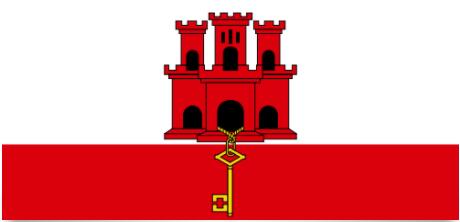Gibraltar Flag and Meaning
Flag of Gibraltar

Gibraltar Flag Meaning
Gibraltar Overview
| Population | 28,000 |
| Currency | UK £ |
| Area | 10 km² |
| Capital city | Gibraltar |
| Population density | 2800 residents/km² |
Peninsula located on the southern tip of the Iberian Peninsula. It is located only 32 km from the coast of Morocco. Its strategic location makes it possible to control maritime traffic between the Mediterranean and the Atlantic.
The People: The majority of the permanent population is of British descent. Among the non-permanent population, the majority are Spanish workers.
Religion: Anglican and Catholic
Languages: English (official) and Spanish
Official Name: Gibraltar
Government: Non-autonomous territory under UN supervision. It is administered by the UK. The Governor General is appointed by the English Crown. Since January 2016, it’s Edward Davis. Prime Minister since December 2011: Fabian Picardo. He is appointed by an advisory council of 15 members elected by the population. In September 96, NATO’s High Command acknowledged that Spain ‘s future military control must be carried out by Sparesidents
The Gibraltar Rock was occupied by England in 1704 and officially surrendered by Spain in 1714 under the Treaty of Utrecht. Since 1964, Spain has again sought political control over the area. In 1967, a referendum indicated that the population wanted to continue under English colonial rule. In 1968, the United Nations voted for the incorporation of Gibraltar into Spain. After 1972, the two countries have repeatedly negotiated to bring the conflict to an end, but without significant progress to date.
In May 2002, a new attempt was made to break the stalemate between Spain and Britain when Spanish Prime Minister Aznar visited his British counterpart Tony Blair in London. In July, British interior minister Jack Straw declared that Britain was willing to share sovereignty over the rock with Spain, but in a November referendum, only 187 out of 17,900 voters voted in favor of the proposal. The result, however, aroused cheer among the people of Gibraltar.
The division of sovereignty remained relevant in 2004, Tony Blair declared when he met Aznar’s possible successor, Mariano Rajoy.
In 2006, the United Kingdom continued to have 558 soldiers in Gibraltar. By then, negotiations on a new constitution for the colony had ended. The new constitution does not change the status of the colony, but modernizes the relationship between it and the colonial power. The new constitution was adopted by a referendum in November and came into force in January 2007.
The Spanish Foreign Minister visited Gibraltar in July 2009 as part of tripartite negotiations. It was the first official Spanish visit to the Crown Colony since its resignation in 1704. Foreign Minister Miguel Ángel Moratinos declared during a press conference that Spain’s claim of sovereignty over Gibraltar remained relevant and would not be abandoned.
Following the election of the fascist PP government in Spain in December 2011, Spain took a much more aggressive stance on Gibraltar and the United Kingdom. In 2012, Queen Sofia canceled her participation in Queen Elizabeth’s diamond anniversary. In July 2013, the conflict intensified sharply. It began when Gibraltar dumped cement blocks into the sea to protect the coastline. The Spanish government protested and claimed the embarrassed Spanish fishing boats in the area. The Spanish government responded again by drastically increasing the control of cars in and out of Gibraltar. The consequence was that it took up to 7 hours to cross the border. At the beginning of August, Spain escalated the conflict further as the Minister of the Interior raised the possibility of charging a fee of 50 Euro for each crossing the border, closed the Spanish airspace for flights to Gibraltar and demanded that servers used for gaming be moved to Spain in order for them to come under the Spanish tax system. The increasingly unpopular Spanish government used the conflict with Gibraltar to whip up a nationalist sentiment. Gibraltar, in turn, demanded to “get something for the tax crowns” in the form of protection from the colonial power. Except that Gibraltar does not pay taxes to the British state at all.
At the Brexit vote in the UK in June 2016, an overwhelming share of Gibraltar voters voted to remain in the EU. The outcome of the referendum – the British withdrawal from the EU – led Spain to make new demands to be included with Britain in the rule of the colony. It was rejected. Spain subsequently stated that the agreements the UK would negotiate with the EU would not apply to Gibraltar. A warning that the relatively open border between Gibraltar and Spain would not remain open. Thus, a warning that the future of the colony would become more difficult.













































